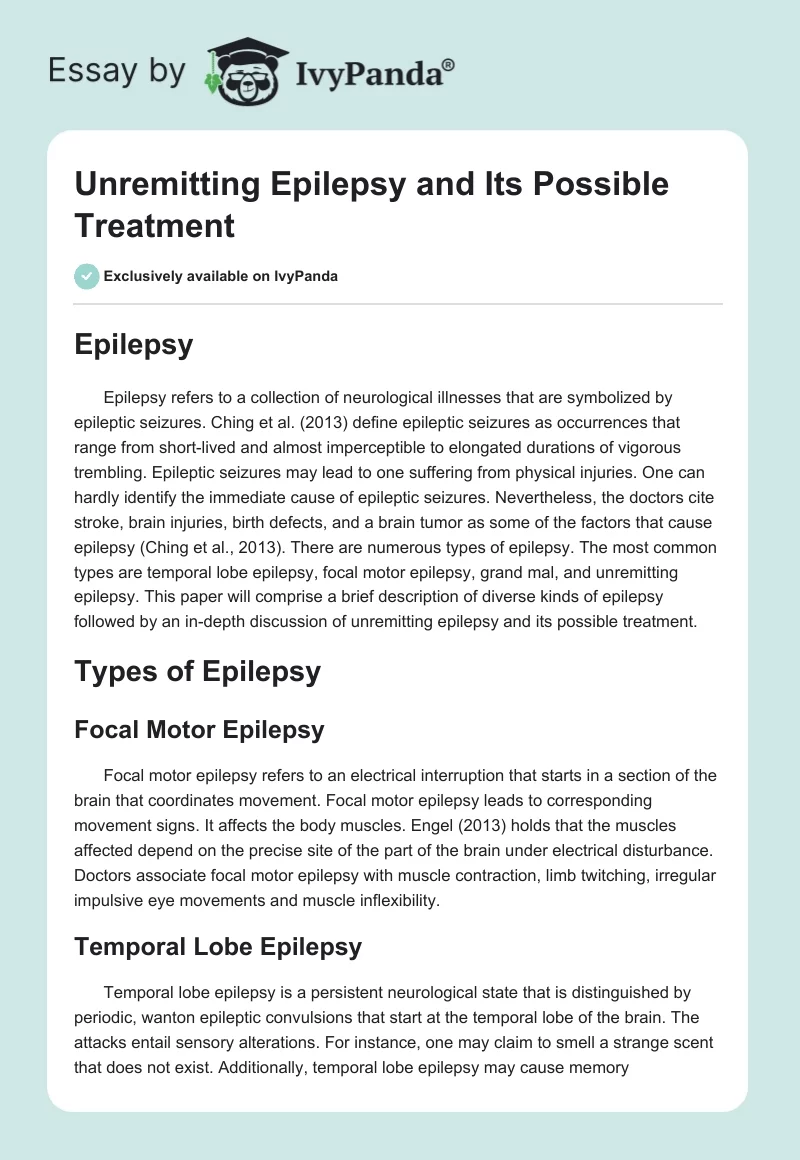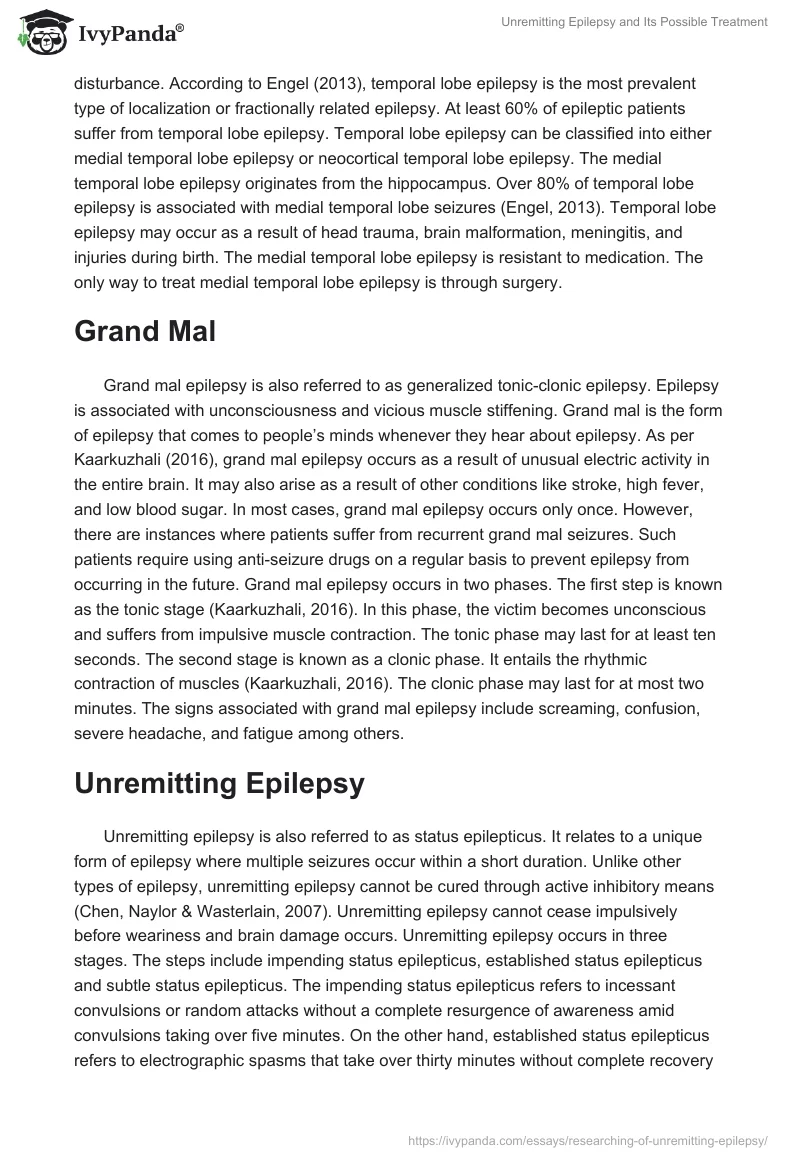Epilepsy
Epilepsy refers to a collection of neurological illnesses that are symbolized by epileptic seizures. Ching et al. (2013) define epileptic seizures as occurrences that range from short-lived and almost imperceptible to elongated durations of vigorous trembling. Epileptic seizures may lead to one suffering from physical injuries. One can hardly identify the immediate cause of epileptic seizures. Nevertheless, the doctors cite stroke, brain injuries, birth defects, and a brain tumor as some of the factors that cause epilepsy (Ching et al., 2013). There are numerous types of epilepsy. The most common types are temporal lobe epilepsy, focal motor epilepsy, grand mal, and unremitting epilepsy. This paper will comprise a brief description of diverse kinds of epilepsy followed by an in-depth discussion of unremitting epilepsy and its possible treatment.
Types of Epilepsy
Focal Motor Epilepsy
Focal motor epilepsy refers to an electrical interruption that starts in a section of the brain that coordinates movement. Focal motor epilepsy leads to corresponding movement signs. It affects the body muscles. Engel (2013) holds that the muscles affected depend on the precise site of the part of the brain under electrical disturbance. Doctors associate focal motor epilepsy with muscle contraction, limb twitching, irregular impulsive eye movements and muscle inflexibility.
Temporal Lobe Epilepsy
Temporal lobe epilepsy is a persistent neurological state that is distinguished by periodic, wanton epileptic convulsions that start at the temporal lobe of the brain. The attacks entail sensory alterations. For instance, one may claim to smell a strange scent that does not exist. Additionally, temporal lobe epilepsy may cause memory disturbance. According to Engel (2013), temporal lobe epilepsy is the most prevalent type of localization or fractionally related epilepsy. At least 60% of epileptic patients suffer from temporal lobe epilepsy. Temporal lobe epilepsy can be classified into either medial temporal lobe epilepsy or neocortical temporal lobe epilepsy. The medial temporal lobe epilepsy originates from the hippocampus. Over 80% of temporal lobe epilepsy is associated with medial temporal lobe seizures (Engel, 2013). Temporal lobe epilepsy may occur as a result of head trauma, brain malformation, meningitis, and injuries during birth. The medial temporal lobe epilepsy is resistant to medication. The only way to treat medial temporal lobe epilepsy is through surgery.
Grand Mal
Grand mal epilepsy is also referred to as generalized tonic-clonic epilepsy. Epilepsy is associated with unconsciousness and vicious muscle stiffening. Grand mal is the form of epilepsy that comes to people’s minds whenever they hear about epilepsy. As per Kaarkuzhali (2016), grand mal epilepsy occurs as a result of unusual electric activity in the entire brain. It may also arise as a result of other conditions like stroke, high fever, and low blood sugar. In most cases, grand mal epilepsy occurs only once. However, there are instances where patients suffer from recurrent grand mal seizures. Such patients require using anti-seizure drugs on a regular basis to prevent epilepsy from occurring in the future. Grand mal epilepsy occurs in two phases. The first step is known as the tonic stage (Kaarkuzhali, 2016). In this phase, the victim becomes unconscious and suffers from impulsive muscle contraction. The tonic phase may last for at least ten seconds. The second stage is known as a clonic phase. It entails the rhythmic contraction of muscles (Kaarkuzhali, 2016). The clonic phase may last for at most two minutes. The signs associated with grand mal epilepsy include screaming, confusion, severe headache, and fatigue among others.
Unremitting Epilepsy
Unremitting epilepsy is also referred to as status epilepticus. It relates to a unique form of epilepsy where multiple seizures occur within a short duration. Unlike other types of epilepsy, unremitting epilepsy cannot be cured through active inhibitory means (Chen, Naylor & Wasterlain, 2007). Unremitting epilepsy cannot cease impulsively before weariness and brain damage occurs. Unremitting epilepsy occurs in three stages. The steps include impending status epilepticus, established status epilepticus and subtle status epilepticus. The impending status epilepticus refers to incessant convulsions or random attacks without a complete resurgence of awareness amid convulsions taking over five minutes. On the other hand, established status epilepticus refers to electrographic spasms that take over thirty minutes without complete recovery of awareness amid convulsions. The transition from impending status epilepticus to established epilepticus is perhaps a gamut, and can only be estimated using time variables. Subtle epilepticus refers to the “burned-out stage of status epilepticus during which both the motor and electroencephalographic (EEG) expression of seizures becomes less florid” (Chen et al., 2007, p. 8).
Unremitting epilepsy is a life-threatening health condition and can kill if not addressed promptly. It may affect individuals who have ever suffered from other forms of epilepsy. Further, unremitting epilepsy may affect people who suffer from brain problems. The problems may include infections, trauma, and stroke (Chen et al., 2007).
Symptoms of Unremitting Epilepsy
There are two forms of unremitting epilepsy, which are unremitting convulsive and nonconvulsive epilepsy. Regular routines of twitching and stretching of legs and hands characterize relentless convulsive epilepsy (Chen et al., 2007). On the other hand, a comparatively long period of transformation in an individual’s degree of awareness without significant contraction and extension of the arms because of convulsion bustle characterize the unremitting nonconvulsive epilepsy. The two forms of unremitting epilepsy are diagnosed through numerous blood tests, testing the blood sugar, electroencephalogram, and head x-ray among other methods.
Treatment
The most common approach to treating unremitting epilepsy is the administration of benzodiazepines drugs. The drugs include diazepam and lorazepam. Ching et al. (2013) claim that intravenous lorazepam is useful in managing seizures. On the other hand, intramuscular midazolam helps to control seizures among victims who are at home. In the absence of lorazepam or in a situation where it is hard to use intravenous, one can administer diazepam. In the Netherlands, the doctors recommend the use of clonazepam as the first choice. The primary advantage of clonazepam over diazepam is that it remains useful for a long duration.
Apart from the use of benzodiazepines, the doctors may conduct invasive brain surgery or use vagal nerve stimulation (VNS) (Ching et al., 2013). The treatment approach entails implanting a device on the vagal nerve with the objective of minimizing the inception of unremitting epilepsy. Doctors have found vagal nerve stimulation to be effective in reducing unremitting seizures in patients.
Conclusion
Epilepsy is a collection of neurological diseases, which are distinguished by epileptic seizures. A person with epilepsy may suffer from physical injuries if left without care. Doctors maintain that it is hard to identify the cause of epilepsy. Nevertheless, they recognize a stroke, brain injuries, birth defects, and brain tumors as some of the causes of epilepsy. The various types of epilepsy include focal motor epilepsy, temporal lobe epilepsy, grand mal, and unremitting epilepsy. Multiple seizures that occur within a short period characterize unremitting epilepsy. The two forms of unremitting epilepsy are convulsive and nonconvulsive epilepsy. The illness can be treated through the use of benzodiazepines. Additionally, the doctors may use the vagal nerve stimulation technique in the case an invasive brain surgery proves ineffective.
References
Chen, J., Naylor, D., & Wasterlain, C. (2007). Advances in the pathophysiology of status epilepticus. Acta Neurologica Scandinavica, 115(1), 7-15.
Ching, J., Khan, S., White, P., Reed, J., Ramnarine, D., Sieradzan, K., & Sandeman, D. (2013). Long-term effectiveness and tolerability of vagal nerve stimulation in adults with intractable epilepsy: A retrospective analysis of 100 patients. British Journal of Neurosurgery, 27(2), 228-234.
Engel, J. (2013). Seizures and epilepsy (2nd ed.). Oxford: Oxford University Press.
Kaarkuzhali, K. (2016). Epilepsy. Annals of Internal Medicine, 164(3), 9-15.


